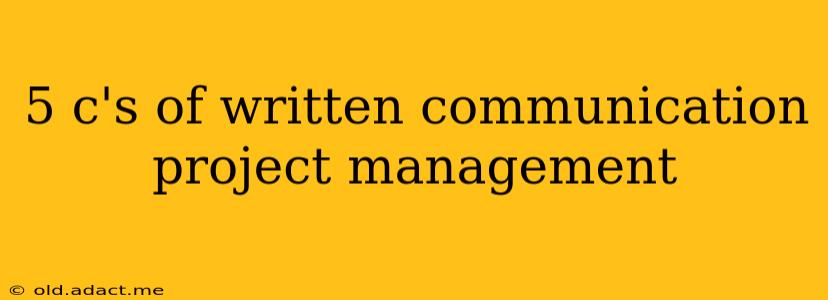Effective communication is the bedrock of successful project management. Within that communication, written communication plays a crucial role, forming the foundation for documentation, updates, and collaboration. Mastering the five C's of written communication—Clarity, Conciseness, Correctness, Coherence, and Courtesy—will significantly enhance your project management skills and lead to smoother, more efficient projects.
1. Clarity: Ensuring Your Message is Easily Understood
Clarity is paramount. Your written communication should be easily understood by your audience, regardless of their technical expertise. Ambiguity breeds confusion and errors, potentially derailing your project. To achieve clarity:
- Use precise language: Avoid jargon, slang, or overly technical terms unless you're certain your audience understands them. If you must use specialized terms, provide clear definitions.
- Structure your writing logically: Use headings, subheadings, bullet points, and numbered lists to break down information into digestible chunks. This improves readability and allows readers to quickly find the information they need.
- Define your purpose upfront: State your objective clearly at the beginning of your communication. This sets the context and helps your reader focus on the key message.
- Provide context: Ensure your communication is easily understood within the broader project context. Refer to previous communications or decisions as needed.
2. Conciseness: Getting Straight to the Point
In project management, time is a precious resource. Concise writing respects your audience's time by delivering information efficiently. Avoid unnecessary words, phrases, or sentences. To achieve conciseness:
- Eliminate redundancies: Avoid repeating the same information multiple times.
- Use strong verbs: Strong verbs add energy and precision to your writing.
- Get rid of filler words: Words like "very," "really," and "actually" often add little value.
- Focus on essential information: Prioritize the key points and leave out anything irrelevant.
3. Correctness: Accuracy and Professionalism
Correctness encompasses both grammatical accuracy and factual accuracy. Errors undermine your credibility and can lead to misunderstandings. To achieve correctness:
- Proofread carefully: Before sending any written communication, thoroughly proofread it for grammatical errors, spelling mistakes, and punctuation issues.
- Verify your facts: Ensure all the information you present is accurate and up-to-date. Double-check figures, dates, and other crucial details.
- Maintain consistent formatting: Use a consistent style guide for formatting, such as font size, spacing, and headings.
4. Coherence: Ensuring a Logical Flow
Coherence means your communication flows logically and smoothly. The ideas should be connected in a way that is easy to follow. To achieve coherence:
- Use transition words and phrases: Use words and phrases like "however," "therefore," "in addition," and "as a result" to connect ideas and show relationships between them.
- Maintain a consistent point of view: Stick to either the first person ("I," "we") or the third person ("he," "she," "they") throughout your communication.
- Organize information logically: Present information in a sequence that makes sense to your reader.
5. Courtesy: Respectful and Professional Tone
Maintaining a courteous and professional tone is essential for building positive relationships with stakeholders. Your writing should be respectful, considerate, and positive. To achieve courtesy:
- Use a professional tone: Avoid slang, informal language, and emotional outbursts.
- Be respectful of your audience: Address your audience appropriately and consider their perspective.
- Use polite language: Use words like "please" and "thank you" when appropriate.
- Proofread for tone: Check that your writing conveys the intended tone.
How to improve your written communication skills in project management?
Improving written communication in project management requires consistent effort and practice. Consider these strategies:
- Seek feedback: Ask colleagues or mentors to review your writing and provide constructive criticism.
- Read widely: Reading well-written materials helps you learn from successful examples.
- Take a writing course: A formal course can provide structured learning and feedback.
- Use templates: Employ templates for common communication types (e.g., meeting minutes, project updates) to ensure consistency and completeness.
By consistently applying the 5 C's to your written communication, you can dramatically improve your effectiveness as a project manager, leading to clearer communication, fewer misunderstandings, and ultimately, more successful projects.
